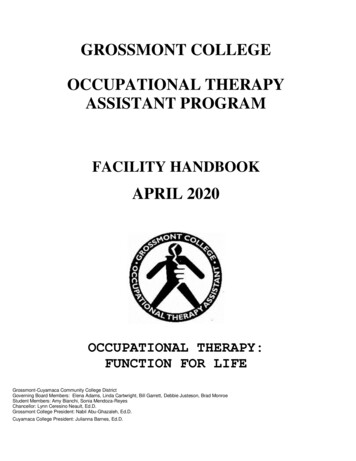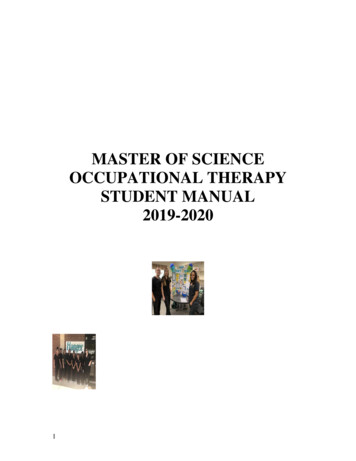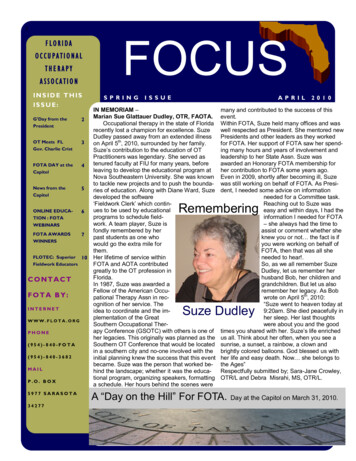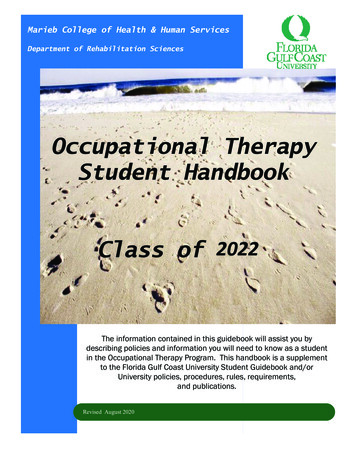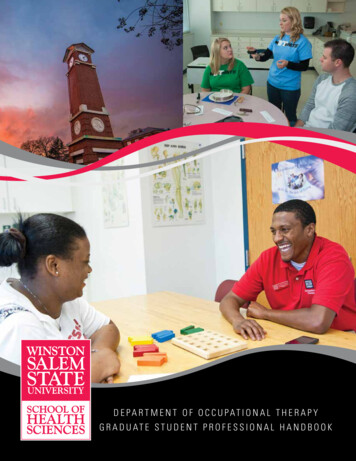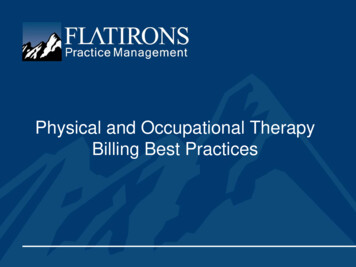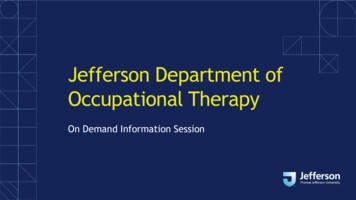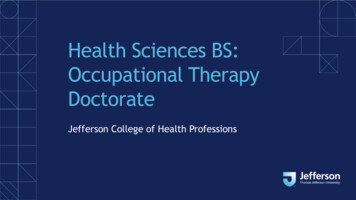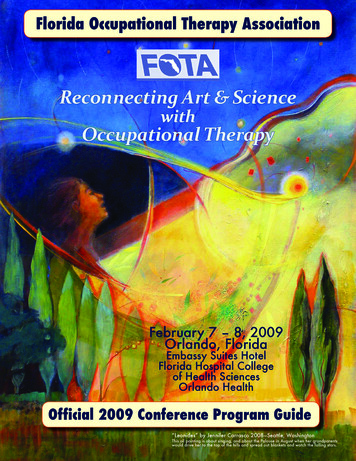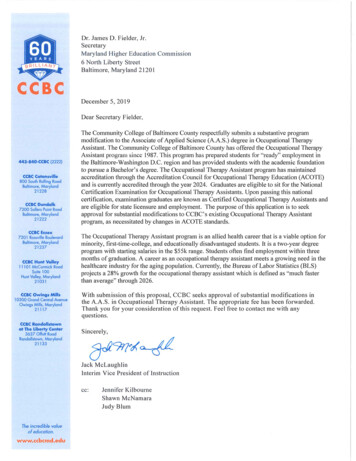
Transcription
Occupational Therapy Assistant Program at the Community College of Baltimore CountySubstantial Modification to an Existing Program ProposalA. Centrality to Institutional Mission and Planning Priorities:1. Provide a description of the program, including each area of concentration (if applicable),and how it relates to the institution’s approved mission.The domain of occupational therapy focuses on an individual’s ability to fully participate ineveryday life activities which lead to being a self-sufficient and a contributing member ofsociety. Occupational therapy practitioners work with clients of all ages, to promotemeaningful health, well-being, and independence. Occupational therapy practitioners maybe employed in hospitals, rehabilitation centers, sub-acute facilities, psychiatric facilities,community based social programs, school systems, home health, outpatient clinics, grouphomes, sheltered workshops, daycare centers, and hospice. This list is not all-inclusive.There are two levels to the allied health profession of occupational therapy. Theoccupational therapist is a graduate of a master’s or doctoral level program. Theoccupational therapy assistant is a graduate of a two year degree program who worksunder the supervision of the occupational therapist.The Community College of Baltimore County has offered the Occupational TherapyAssistant program since 1987. This program has prepared students for “ready” employmentin the Baltimore Washington D.C. region and has provided students with the academicfoundation to pursue a Bachelor’s degree. The Occupational Therapy Assistant program hasmaintained accreditation through the Accreditation Council for Occupational TherapyEducation (ACOTE) and is currently accredited through the year 2024. Graduates areeligible to sit for the National Certification Examination for Occupational TherapyAssistants. Upon passing this national certification examination graduates are known asCertified Occupational Therapy Assistants and are eligible for state licensure andemployment.“The Community College of Baltimore County transforms lives by providing accessible,affordable, and high-quality education that prepares students for transfer and careersuccess, strengthens the regional workforce, and enriches our community.”The Occupational Therapy Assistant program supports the College mission of providing“accessible” and “affordable” education since it is the only Occupational Therapy Assistantprogram housed in a public institution in the Baltimore-Washington D.C. area. The College’smission of providing “high quality education” is reflected in this program’s: Uninterrupted accreditation status with ACOTE since 1988 Average retention rate of 95% Two year completion rate of 90% Average pass rate of 95.6% for graduates on the National Certification Examinationbetween the years of 2014 and 2018 Employment of graduates within 3 months of initiating a job search Feedback from Employer Surveyed which indicated on a scale of 1-5 that OTAgraduates demonstrate job skills and knowledge at “above average” (4.01 on a 5.0scale).1
The purpose of this application is to seek approval for substantial modifications to CCBC’s existingOccupational Therapy Assistant program, as necessitated by changes in national ACOTEaccreditation standards.2. Explain how the proposed program supports the institution’s strategic goals and provideevidence that affirms it is an institutional priority.CCBC strategic goals:How OTA Program supports CCBC strategicgoals: Enrollment Stabilization Transformational Academics Economic Stabilization Credit/Continuing Education Integration Advisement of students by faculty,throughout enrollment in programOrientation at start of programQ & A sessions for prospectivestudents each semesterApplication through CASUse of clinical placements for trainingwhich often lead to job offersWork ready skills90-100% employment within 3months of graduation90% pass rate on National BoardexaminationInstruction provided by currentclinicians practicing in regionalhealthcare facilitiesFaculty utilize multiple teachingstrategies to reinforce skills in a safelearning environmentPromotion of use of “Tools forSuccess” and the retention specialistfor SHPReferral to Success Navigators whenappropriateCollaboration with other alliedhealth/nursing programs for use oflab equipment to reduce costsParticipation in bulk order for costreductionAdvisory board is populated witharea industry partnersOver 75 clinical partnerships witharea healthcare facilitiesOffer Continuing Educationopportunities for occupational2
therapy practitioners in theBaltimore Washington DC areaGuarantee a seat for a CE studentwho has completed a certificationprogram and successfully meets allthe prerequisite coursework for theOTA programOffer opportunities for the PT aidprogram to view the OTA lab3. Provide a brief narrative of how the proposed program will be adequately funded for atleast the first five years of program implementation. (Additional related information isrequired in section L).This program has been adequately funded since its inception in 1987. The proposedcurriculum and course content changes will not impact current funding of this program.The curriculum and course content changes will not require additional faculty, lab space, orequipment.4. Provide a description of the institution’s a commitment to:a) ongoing administrative, financial, and technical support of the proposed programAs stated above this program has been in existence at the Community College of BaltimoreCounty since 1987. It has always been provided adequate administrative, financial andtechnical support. This program has its own lab space with adequate equipment for up-todate instruction.b)continuation of the program for a period of time sufficient to allow enrolledstudents to complete the program.The Occupational Therapy Assistant program was approved by CCBC’s College Senate,President and Board of Trustees in 1987. It has undergone periodic Program Review whereit has been granted “continuance” over the years. The program has also had four reaccreditation cycles with on-site visits from ACOTE which have resulted in continuedaccreditation since 1988.B. Critical and Compelling Regional or Statewide Need as Identified in the State Plan:1. Demonstrate demand and need for the program in terms of meeting present and futureneeds of the region and the State in general based on one or more of the following:a) The need for the advancement and evolution of knowledgeb)Societal needs, including expanding educational opportunities and choices forminority and educationally disadvantaged students at institutions of highereducation3
c) The need to strengthen and expand the capacity of historically black institutions toprovide high quality and unique educational programsThe Occupational Therapy Assistant program is an allied health career that is a viable option forminority, first-time college, and educationally disadvantaged students to pursue. It is a two yeardegree program with starting salaries in the 55k range. Students often find employmentwithin three months of graduation. A career as an occupational therapy assistant meets agrowing need in the healthcare industry for the aging population. Currently, the Bureau ofLabor Statistics (BLS) projects a 28% growth for the occupational therapy assistant which isdefined as “much faster than average” through 2026. As such, the Occupational TherapyAssistant program meets a societal needProvide evidence that the perceived need is consistent with the Maryland State Plan forPostsecondary EducationGoal 1: Ensure equitable access to affordable and quality postsecondary education for allMaryland residents.The Occupational Therapy Assistant program is the only such program in the BaltimoreMetropolitan region. It is affordable as it is provided in the community college tuitionstructure. The program has maintained accreditation through the Accreditation Council forOccupational Therapy Education since 1988. The pass rates on the National Board forCertification of Occupational Therapy 95.6% for the past 5 years. Many of the faculty in theOccupational Therapy Assistant program are full time clinicians from area hospitals andhealthcare facilities resulting in students being trained in the most up to date skills requiredof the occupational therapy practitioner.Goal 2: Promote and implement practices and policies that will ensure student success.The School of Health Professions (SHP) is the largest educator of health care professionalsin the State of Maryland. SHP has demonstrated commitment to the completion agenda byproviding supplemental instruction and tutoring for all programs within the school.Through these services and a dedicated faculty, retention rates throughout the school haveincreased over the past three years.The retention for the Occupational Therapy Assistant program range from 85% to 100%year in and year out. This program continues to promote success by supporting aknowledge-based economy through education and training. This program has been and willcontinue to produce a pipeline of skilled graduates who are prepared to take thecertification examination and enter the workforce in the Baltimore-Washington D.C. region.Students from the Occupational Therapy Assistant program have an 88%-100% pass rateon the National Certification Examination for Occupational Therapy Assistants. Graduatesare often employed within three months of graduation.4
Goal 3: Foster innovation in all aspects of Maryland higher education to improve access and studentsuccess.The School of Health Professions at CCBC is one of the few community colleges in thecountry that is addressing Interprofessional Education and Collaboration. This initiativewas supported by a grant and has allowed for the training of faculty and creation ofInterprofessional education opportunities for students across many disciplines inhealthcare. The students in the Occupational Therapy Assistant program have participatedin simulations, case studies, a health mentor program and workshops all with the focus ofInterprofessional Education and collaboration. The skills learned in an InterprofessionalEducation environment assists our students in being better healthcare team members. It isa skill set highly desired by area healthcare facilities.In addition, students in the Occupational Therapy Assistant program will benefit from thenew Eustis Center for Health Professionals on the Essex campus. This new state of the artfacility will house simulation and standardized patient labs, debriefing rooms, a fullyoutfitted apartment and conference rooms for collaborative learning across disciplines.C. Quantifiable and Reliable Evidence and Documentation of Market Supply and Demand inthe Region and State:1. Describe potential industry or industries, employment opportunities, and expected level ofentry (ex: mid-level management) for graduates of the proposed program.Occupational Therapy Assistants must be graduates of a two year ACOTE accredited degreeprogram in order to sit for the National Examination for Occupational Therapy Assistantsand for state licensure. Occupational Therapy Assistants work under the supervision of theOccupational Therapist who is a graduate of a master’s or doctoral level program.Graduates from the Occupational Therapy Assistant program are in high demand with closeto 100% employment within 3 months of graduating.At this point in time the American Occupational Therapy Association and its accreditingbody, Accreditation Council for Occupational Therapy Education (ACOTE), have notmandated the occupational therapy assistant programs move to a baccalaureate level.2. Present data and analysis projecting market demand and the availability of openings in ajob market to be served by the new program.The profession of occupational therapy has been one of the fastest growing professionsidentified by the BLS for the past 10 years. Currently, the BLS projects a 28% growth for theoccupational therapy assistant which is defined as “much faster than average.” The averagestarting salary for graduates is around 55,000.5
3. Discuss and provide evidence of market surveys that clearly provide quantifiable andreliable data on the educational and training needs and the anticipated number of vacanciesexpected over the next 5 years.Table 1 below demonstrates Maryland’s potential demand for graduates from theOccupational Therapy Assistant program. The evidence provided is based upon theprogram’s proposed Classification of Program (CIP) code of 51.0803 (Occupational TherapyAssistant) and cross referenced with the Bureau of Labor Statistics Standard OccupationalClassifications (SOC) that classify and indicate the professions and occupations of graduatesof programs with this CIP code are likely to pursue.Table 1: Maryland Occupational Projections 2016-2026 for the Occupational TherapyAssistant pational sTotal8291699081077This data indicates the potential for 1077 new and additional positions that theOccupational Therapy Assistant program prepares graduates for, over the next ten years.This translates into approximately 107 positions per year in the State of Maryland. Thesource for completing Table 1 was https://www.bls.gov/soc/2018/major groups.htm land.shtml.4. Provide data showing the current and projected supply of prospective graduates.6
Table 2: Annual Graduations from Programs in Maryland Institutions with the CIP designation 51.0803 (Occupational TherapyAssistant):SchoolNameDegree Program ProgramLevelIDName(HEGIS)CIPApproved(A)/2014 2015 2016 2017 2018Discontinued(D)AlleghanyAAS5210-01Occupational 51.0803 A92College ofTherapyMarylandAssistantCommunity AAS5210-01Occupational 51.0803 A85College 311CountyWor-Wic\AAS5210-01Occupational 51.0803 A14CommunityTherapyCollegeAssistantTable 2 outlines the current supply of graduates from Maryland programs with the CIP taxonomy of 51.0803 (Occupational TherapyAssistant program). This data reveals that in 2018, Maryland institutions graduated 60 graduates in the Occupational Therapy Assistantprograms. It also demonstrates that the State has 3 programs in this area available for the Associates of Applied Science degree.7
D. Reasonableness of Program Duplication:1. Identify similar programs in the State and/or same geographical area. Discuss similaritiesand differences between the proposed program and others in the same degree to beawarded.According to Table 2 above, two other programs similar to the Occupational TherapyAssistant program at CCBC exist in the State of Maryland, yet, none of these programs servethe greater Baltimore region. The CCBC Occupational Therapy Assistant program does fillan existing void in the Baltimore region and assists Maryland in fulfilling an importantworkforce demand.2. Provide justification for the proposed program.The CCBC Occupational Therapy Assistant program was the first of its kind in the state ofMaryland, established in 1987. It does not compete with the two other OTA programs in thestate due to geographic location and distance. The OTA program at Alleghany College ofMaryland primarily serves the western part of Maryland. Wor-Wic Community Collegeserves the eastern shore area of Salisbury and Ocean City Maryland.E. Relevance to High-demand Programs at Historically Black Institutions (HBIs)1. Discuss the program’s potential impact on the implementation or maintenance of highdemand programs at HBI’s.Table 2 demonstrates that no Historically Black Colleges or Universities currently offer theOccupational Therapy Assistant program. Howard University in Washington D.C. does offera master’s degree in Occupational Therapy. Students in the CCBC OTA program are madeaware of the existence of the Occupational Therapy program at Howard University butthere is no formal articulation due to the degree being offered at the master’s level.F. Relevance to the identity of Historically Black Institutions (HBIs)1. Discuss the program’s potential impact on the uniqueness and institutional identities andmissions of HBIs.The CCBC Occupational Therapy Assistant program has been part of the Chesapeake BayFieldwork Council since its inception in the early 90’s. This council is made up of OTA and OTprograms in the Maryland/Washington DC area. It is through this Council that the CCBC OTAprogram interacts with Howard University’s OT program and faculty in an attempt to addressfieldwork (clinical) issues germane to all schools in the Baltimore-Washington D. C. Region.8
G. Adequacy of Curriculum Design, Program Modality, and Related Learning Outcomes (asoutlined in COMAR 13B.02.03.10):1. Describe how the proposed program was established, and also describe the faculty who willoversee the program.Substantial program change proposals at CCBC are reviewed and approved according tothe process developed through college governance, which includes approval by theCurriculum and Instruction Committee and the full College Senate. In addition, thissubstantial program change proposal was carefully reviewed by the President and herSenior Staff prior to submission to the CCBC Board of Trustees for their endorsement. ThePresident has affirmed that the program changes can be implemented within existinginstitutional resources. Judith Blum will continue to serve as the coordinator of theOccupational Therapy Assistant program.These substantial program changes being proposed will not necessitate additional faculty,equipment nor financial resources.2. Describe educational objectives and learning outcomes appropriate to the rigor, breadth,and (modality) of the program.The Occupational Therapy Assistant Program will recruit and educate a diverse group ofstudents who will demonstrate:1. Engagement in the learning process2. Recognition in the value of lifelong learning3. Competency in the skills of an entry level occupational therapy assistant in order to work ineither a traditional or non-traditional setting4. Critical thinking skills5. Advocating for both the client and profession of occupational therapy at the regional andnational level6. Skills necessary to be a culturally competent practitioner7. Interprofessional and collaborative care competencies when working with the healthcareteam8. Understanding of role delineation and the practice act in state of Maryland9. Skills of an evidence based practitioner10. Compliance with the Code of Ethics and Standards of Practice for Occupational Therapy11. Success in sitting for the National Certification Examination for Occupational TherapyAssistantThe learning outcomes are the program-level objectives that students will attain prior tograduation. These are the outcomes that are posted in the college catalog.PROFESSIONALISM: Conform to behaviors consistent with AOTA Standards of Practice, Code of Ethics andMaryland licensureDemonstrate respect for client and right to self determinationAware of issues/trends affecting the profession9
Understand importance of identifying professional abilities and competencies related tojob responsibilitiesInitiate advocating for client rightsDemonstrate a commitment to the profession via participation in AOTA, MOTA, etc.Responsible/proactive in advocating for the profession and for his/her own need forsupervisionDemonstrate professionalism in written, email and verbal interactions with supervisorDemonstrate emerging interprofessional competenciesTERMINOLOGY: Demonstrate working knowledge of psychiatric, pediatric, and physical dysfunctiondiagnoses and medicationsDemonstrate ability to use medical terms and abbreviations appropriatelyDemonstrate working knowledge of Practice FrameworkDemonstrate working knowledge of terminology found in health
Occupational Therapy Assistant program, as necessitated by changes in national ACOTE accreditation standards. 2. Explain how the proposed program supports the institution’s strategic goals and provide evidence that affirms it is an institutional priority. CCBC strategic goals: How OTA
